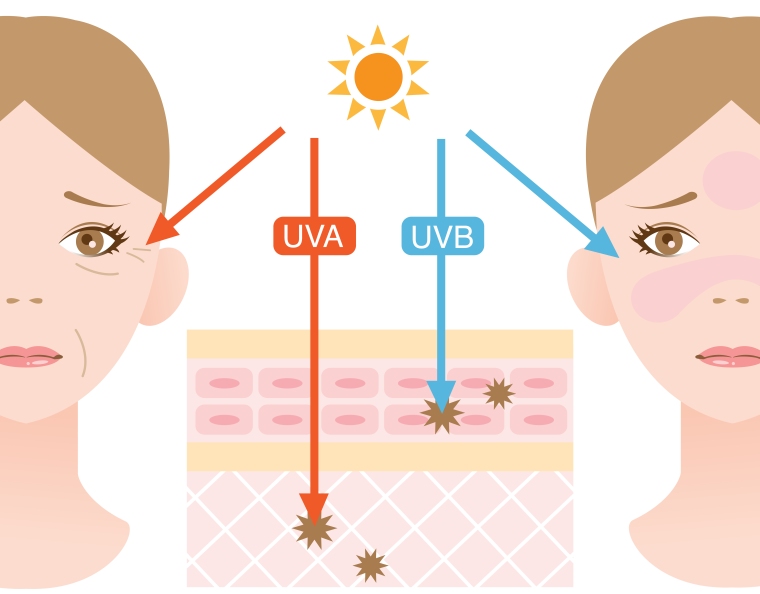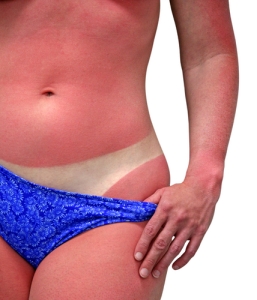Summer is the time where I get alot of questions regarding sunscreens. It’s no wonder… the flood of information out there can be very confusing. I offer up a fairly comprehensive summary of what you need to know this summer to protect your skin. Here are some basics:
Considering that SPF was determined using experiments with 2 mg/cm2 of sunscreen, which is way more than anyone uses in real life (we generally use less than 1/3 of what we are supposed to), we are all getting less protection than we think. For that reason, I usually recommend an SPF of 30 or more (the sun laughs at less than SPF 30, especially here in Miami), one with the label “Broad Spectrum,” and to reapply every two hours. UVB rays cause sunburn and skin cancer, while UVA rays penetrate deeper into the skin, causing skin aging, cell damage, sun spots, and wrinkles by breaking down collagen and elastin. It is important to block both of them, and SPF only indicates the UVB protective power. “Broad Spectrum” indicates that the particular brand also blocks UVA. See this lovely infographic by Dr. Michelle Levy that illustrates how UVA and UVB damage the skin.

Why not use SPF 100? There is a miniscule incremental benefit in protection above SPF 50, so much that the FDA proposed banning the labeling of higher SPFs, as it can be misleading to the public. SPF 100 blocks 99% of harmful UVB rays, while properly applied SPF 50 blocks 98% of the same rays. Something about an SPF of 100 gives people a false sense of security, and they are more likely to improperly use it or expose themselves to the sun for longer. Additionally, there is some evidence that having the very high SPF makes it more difficult to chemically formulate a sunscreen with great UVA protection, which is just as (if not more) important as UVB.

Reapply! The most common reason for sunburn is missing an area of your body and forgetting to reapply every two hours.
There are so many sunscreens on the market, how do I know which one to use?
I classify my sunscreens by the type of use: everyday use, intense sun exposure (like going to the pool or beach), athletic use, and those for babies. Let’s start with babies:
Babies: Baby’s skin at less than 6 months of age hasn’t yet developed the same type of barrier protection as an adult. For that reason, the American Academy of Dermatology will generally recommend sun avoidance or sun protective clothing (look for clothes labeled with UPF- iPlay makes great ones). When sunscreen is needed, a physical sunscreen is best. Physical sunscreens bounce UV rays off the skin, as opposed to chemical sunscreens which are excellent at protecting the skin, but baby is more likely to be sensitive to these products (note: most sunscreens are chemical sunscreens). You can recognize a physical sunscreen because it only has one or two active ingredients: zinc oxide or titanium dioxide. These are some of my favorites: CeraVe Baby, Neutrogena Pure and Free Baby Sunscreen, Blue Lizzard Baby. (I don’t like the one made by the Honest company — I find it very hard to rub in and sticky).
Beach or pool use: As mentioned earlier, a Broad-Spectrum sunscreen with an SPF of at least 30 is best. Water-resistant (now labeled as 40 or 80 minutes) is also a must. The key is to reapply every 2 hours! Pick your favorite and go with it… Sunscreen only works if you use it! Here are some of my favorites: La Roche Posay Sunscreen Milk, Neutrogena Ultra Sheer, Coppertone Oil-Free Faces, Neutrogena Beach Defense.
Everyday Use: Yes, you should be wearing sunscreen every day!!! It’s not only to protect yourself from skin cancer, but if you want to look young, the MOST important intervention is sunscreen! See the difference between these twins, one who practiced sun protective measures, and the other who didn’t. The twin that protected herself from the sun looks at least ten years younger than her twin sister. Having a tan can be nice in the short term, but your skin will pay for it. By the time most people hit age 30, their skin can start to show their prior indiscretions! Time to embrace your inner Anne Hathaway. Pale is beautiful.
The sunscreens I like for everyday use are those that feel like a moisturizer, are very light and sheen, and layer well under makeup. Sunscreen should be layered under your makeup, even if your makeup contains SPF…. it’s not enough. Here are my favorites: Elta MD UV Clear, La Roche Posay AOX Serum, Neutrogena Healthy Defense, CeraVe AM.
Athletic Use: This is a tough one. Intense exercise or very hot conditions cause you to sweat like it’s raining. Even water resistant sunscreens can be tough to keep on, and forget reapplying on that wet skin. I’m still in search for a good one, and would love to hear your comments/recommendations below! I would definitely recommend UPF moisture-wicking clothing for tennis, fishing, or other activities, as these actually keep you more cool than tank tops and have consistent sustainable sun protection.
Sprays: Personally, I love the convenience of sprays. However, it seems like people are more likely to under-apply or miss certain areas of their body, potentially leading to sunburn. There are also some questions about the possibility of inhaling the aerosolized chemicals, and we don’t yet know the dangers of this. I still use sprays sparingly when I need the convenience, but the jury is still out as to their proper role.
When should I be using a non-chemical (a.k.a. physical) sunscreen?
The majority of sunscreens on the market contain excellent scientifically developed chemicals that block a combination of UVB and UVA rays. For the vast majority of people, chemical sunscreens are perfect. In some cases, a physical blocker is preferred. For instance, in babies less than six months of age, I recommend a physical blocker for reasons stated above. There are 3 other scenarios where I prefer physical sunscreens: sensitive skin, rosacea, and melasma.
I know many people who tell me they are allergic to every sunscreen that they have tried. My bet is that they have not yet tried a purely physical sunscreen, as they can be difficult to find. While regular sunscreens have a fairly high rate of allergic contact dermatitis, physical blockers have almost no reactive potential. These are my favorites for non-facial use: Neutrogena Sensitive Skin, Neutrogena Pure and Free Baby Sunscreen, Blue Lizzard. See below for facial sunscreen recommendations.
Do you suffer from flushing, red pimple bumps, skin burning, and/or sensitivity to most products? Well then you might have rosacea, and I definitely prefer for you to wear a physical sunscreen. Rosacea and melasma (those brown patches on the face that come with sun or pregnancy) are very sensitive to heat, and chemical sunscreens produce an imperceptible amount of heat, potentially flaring the skin. In order to minimize anything that can exacerbate rosacea or melasma, I recommend a pure physical sunscreen for these heat sensitive conditions. Physical sunscreens bounce the UV rays off the skin, and are inactive on the skin. In both rosacea and melasma, sunscreen is mandatory. You will find with changing sunscreen alone, your skin may dramatically improve. These are my favorite physical sunscreens for daily facial use: La Roche Posay Anthelios Mineral SPF 50, Elta MD UV Physical SPF 41, SkinCeuticals UV Physical Defense, CeraVe SPF 50 Facial Sunscreen Lotion, Avene Mineral SPF 50. And don’t forget to reapply. For the sake of convenience, I like the following two products to help women reapply sun protection after they have applied their makeup. No one wants to put on a lotion sunscreen to a freshly painted (ahem, made-up) face. Use these products to layer on top of your pretty face throughout the day: Avene compact, Colorescience Sunforgettable Mineral Powder Brush.
In conclusion, don’t forget to practice other sun safe behaviors, such as wearing polarized sunglasses, protective clothing such as hats, UPF clothing, UPF scarves (see these great ones by Blox Sun), and seeking shade during peak hours of UV intensity, 10 am to — 4 pm.
I’d love to hear your thoughts and invite you to comment below!
Stay tuned for my take on the topic of Vitamin D and the Environmental Working Group’s rankings of sunscreens.
Photo credit: Shutterstock
Dr. Jacquelyn Dosal is a board-certified dermatologist practicing in Miami, FL. About Dr. Dosal: http://goo.gl/hbgqZW


4 thoughts on “How to select the best sunscreens”